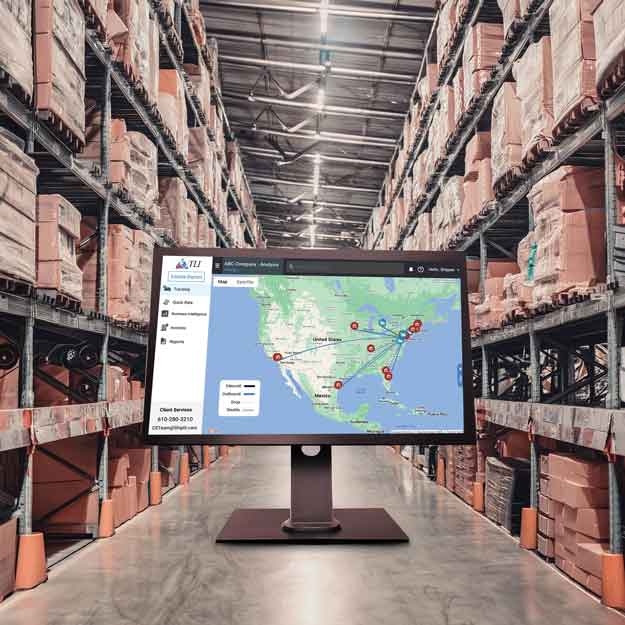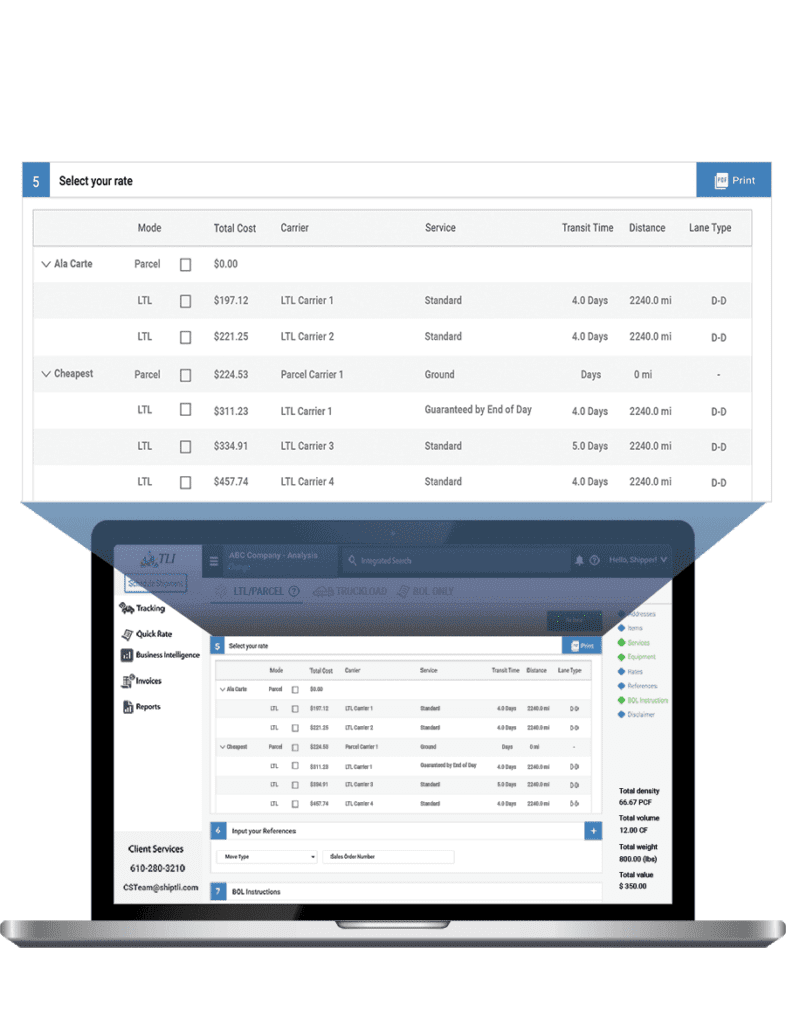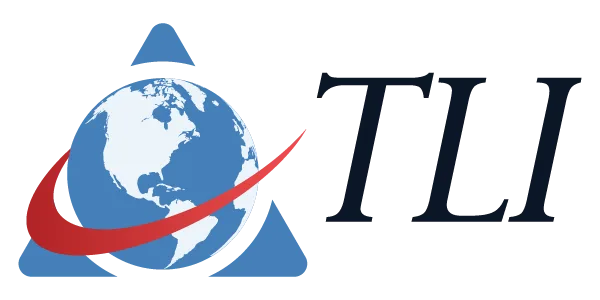A Transportation Management System (TMS) is logistics software that helps businesses manage the movement of freight. It allows shippers to automate routine shipping tasks like carrier selection, rate comparison, tendering, and tracking. Companies use TMS software to gain better control over transportation costs, reduce manual work, and improve visibility across their supply chain.
Whether you ship a few loads per week or manage a large logistics network, a TMS makes the process more efficient and scalable. It simplifies shipping for every department, from logistics to customer service. With real-time access to shipping data and automated workflows, your team can make faster, more accurate decisions.
Relying on spreadsheets or manual processes no longer works. A TMS not only helps businesses stay competitive but also supports long-term growth by scaling with demand and improving supply chain agility. Research exhibits that a TMS is essential for every shipper. Nearly all large shippers—98%—use one, and 83% of small businesses do as well.

How a TMS Reduces Freight Costs
One of the biggest benefits of a Transportation Management System is cost savings. A TMS helps reduce freight spend by comparing motor carrier rates, automating tendering, and identifying the most economical shipping routes. Right from the start, the system is offering shippers cost savings through in-depth carrier vetting using solutions and integrations such as Highway,1 and TIA watchdogs.2 Similarly when it comes to carrier selection, some shippers inquire about the ability of uploading their routing guide. While this is indeed possible with ViewPoint TMS, it is rather obsolete as a processes when compared against dynamic pricing, and density based contracts. The Transportation Management System not only can optimize by mode type, it can also be used to sort by least cost provider based off accessorials, hundred weight, and lane pairing. Instead of relying on guesswork or outdated static rate tables, shippers can instantly find the best option based on price, mode, and delivery timeline.
Over time, the system collects valuable shipping data. This data reveals trends in freight costs, carrier performance, and lane profitability. With this insight, businesses can negotiate better contracts, eliminate inefficiencies, and optimize logistics operations. This data can then be used for forecasting and contract comparison.
By streamlining workflows and reducing errors, a TMS also lowers administrative costs. Fewer manual tasks mean fewer mistakes—and fewer costly delays. Every shipment becomes more predictable, which helps your budget go further. Similarly, it can speed up analytics and reporting. In fact, some shippers just integrate the TMS system directly into their ERP or Microsoft PowerBI to get canned KPI Dashboards. This is highly effective if your company operates under the EOS framework.

The Importance of Real-Time Tracking
Our Transportation Management System integrates directly with TIVE and Descartes MacroPoint to provide live GPS tracking, giving you real-time visibility across all shipments.3 But it doesn’t stop there—we also monitor light exposure, temperature conditions, and other critical factors during transit. Thanks to robust API and EDI integrations, carriers can push updates automatically, making tracking effortless and reliable.
Why does this matter? It’s not just a win for your traffic department. Purchasing and procurement teams also benefit by gaining visibility into inbound inventory and raw materials. This helps ensure production stays on schedule and lines keep running. When it’s time to replenish, you’ll know exactly what’s in transit—and when it will arrive.
Your customers expect accurate delivery updates, and a strong TMS helps you meet those expectations. Whether you’re shipping parcel, LTL, or full truckload, real-time tracking enables your team to react to disruptions quickly and keep clients informed.
With Translogistics’ ViewPoint TMS, you no longer need to chase carriers for status updates. The platform pulls tracking data from multiple carriers and displays it all in one simple dashboard. This reduces confusion, improves team communication, and accelerates issue resolution.
Real-time tracking also enhances performance management. You can easily monitor carrier reliability, on-time delivery rates, and exceptions. If a shipment is delayed, the system alerts your team immediately, so they can act fast and prevent downstream problems.
TMS Software Boosts Team Productivity
A Transportation Management System doesn’t just help with freight—it helps your team. The platform eliminates repetitive tasks like quoting, dispatching, and creating bills of lading. The BOL creation even features an artificial intelligence function enabling drag and drop to quickly generate your BOL. Similarly, it also automates processes that would normally require hours of manual input and coordination. Even load tendering is automated within ViewPoint TMS, when the BOL is created it automatically tenders the pickup to the carrier saving you time camped out on call centers waiting to schedule a pickup.
By storing all transportation documents (BOL/POD Archiving)4 and shipment details in one place, a TMS saves time and reduces errors. Your logistics staff can handle more shipments without increasing headcount. Meanwhile, your customer service team gains faster access to shipping data, helping them respond to questions with speed and confidence.
Today’s cloud-based TMS platforms like ViewPoint are also designed with ease of use in mind. They require little training and are often customizable, so teams can set rules, generate reports, and tailor the system to fit their workflow. As a result, productivity improves across the board.
FAQ: Transportation Management System (TMS)
What does a Transportation Management System do?
A TMS helps manage the entire shipping process—from comparing motor carrier rates and booking shipments to tracking deliveries and auditing invoices.
Is a TMS suitable for small businesses?
Yes. Many TMS platforms offer scalable plans that fit the needs and budgets of small and mid-sized shippers. ViewPoint TMS is used by small family offices to large publicly traded companies.
Does a TMS integrate with other systems?
Our TMS software integrates with ERP platforms, allowing data sharing and workflow automation.
Can a TMS improve customer service?
Absolutely. Real-time tracking and better shipment visibility help customer service teams provide faster, more accurate updates to clients. ViewPoint TMS also has the ability of retrieving tracking and document imaging using your own internal references. For example, customer service could track a shipment using an order number, while purchasing could track using a PO number.
How long does it take to deploy a TMS?
Most small businesses are up and running in under an hour.
Mid-sized shippers typically take 2 to 3 weeks, depending on how much data is ready to upload at the start.
Large publicly traded companies usually complete the rollout in about a month.
What types of shipping can a TMS manage?
A TMS can manage parcel, LTL, volume LTL, full truckload, and even intermodal and international shipments.
Footnotes:
- Highway is a carrier identity management platform, integrated into ViewPoint TMS, that helps shippers and brokers verify, onboard, and monitor carriers. It streamlines compliance checks, reduces fraud risk, mitigates any chance of double brokering, and ensures you’re working with trusted transportation provider that has valid operating authority. ↩︎
- TIA Watchdog is a fraud prevention and reporting tool provided by the Transportation Intermediaries Association (TIA). It allows TIA members to share and access reporting on unethical or fraudulent activity within the freight and logistics industry, helping protect shippers from bad actors. ↩︎
- TIVE is a supply chain visibility platform that provides real-time shipment tracking with sensors for temperature, light, and shock. Descartes MacroPoint is a leading freight visibility solution offering live GPS tracking by connecting with carriers through integrations and mobile technology. Both of these solutions are integrated directly into ViewPoint TMS. ↩︎
- BOL and POD documents are archived and remain readily accessible for up to 7 years. ↩︎
